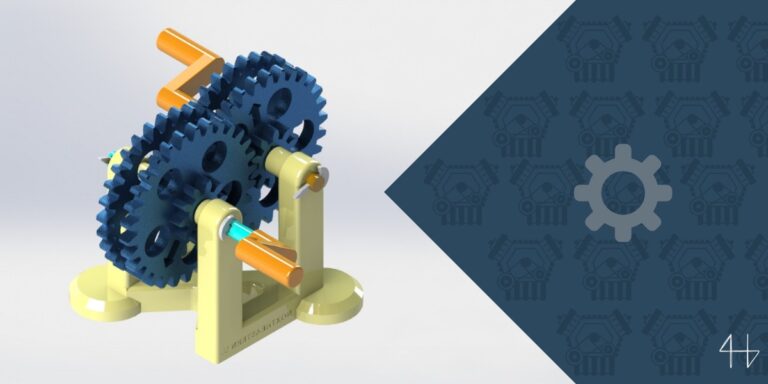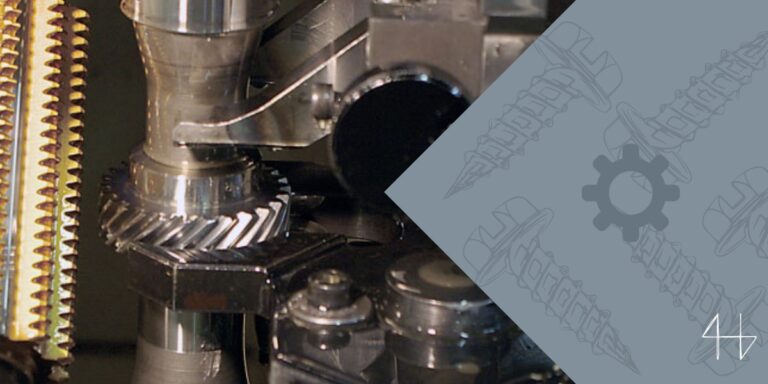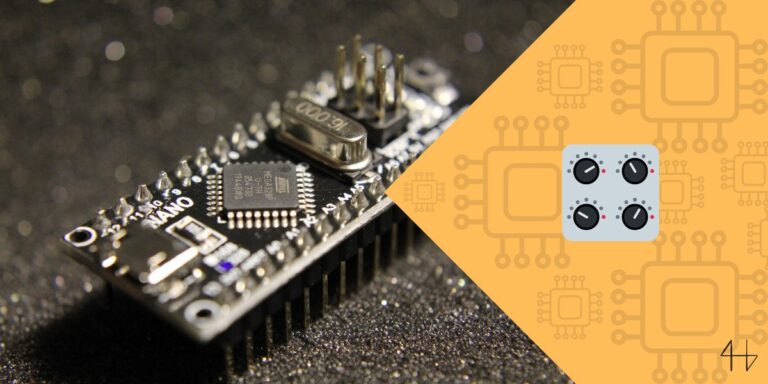IoT is everywhere. From smart devices in homes to industrial IoT devices in factories, connected technology is transforming the way we live and work. But behind the scenes, these IoT sensors and gadgets need a brain to process data, communicate with networks, and make intelligent decisions. That’s where Single Board Computers (SBCs) come in.
Unlike simple microcontrollers, SBCs offer more computing power, connectivity, and flexibility—making them essential for modern IoT applications – particularly in develping smart devices.
So, how do SBCs work? What makes them the right choice for IoT? And how do you pick the best one for your project? Let’s break it down together.
What Are Single Board Computers?
Imagine cramming an entire computer onto a single circuit board—CPU, RAM, storage, and all. That’s exactly what an SBC is!
Unlike traditional desktops with multiple components, single board computers are compact, self-contained, and perfect for powering IoT systems.
Why Are SBCs a Big Deal?
Unlike microcontrollers, which are great for simple tasks like blinking LEDs or reading sensors, single board computers can run full operating systems, process large amounts of IoT data, and even handle machine learning tasks.
They’re mini powerhouses, capable of managing multiple sensors, running cloud applications, running embedded AI on the edge, and keeping your IoT network connected.
What’s Under the Hood?
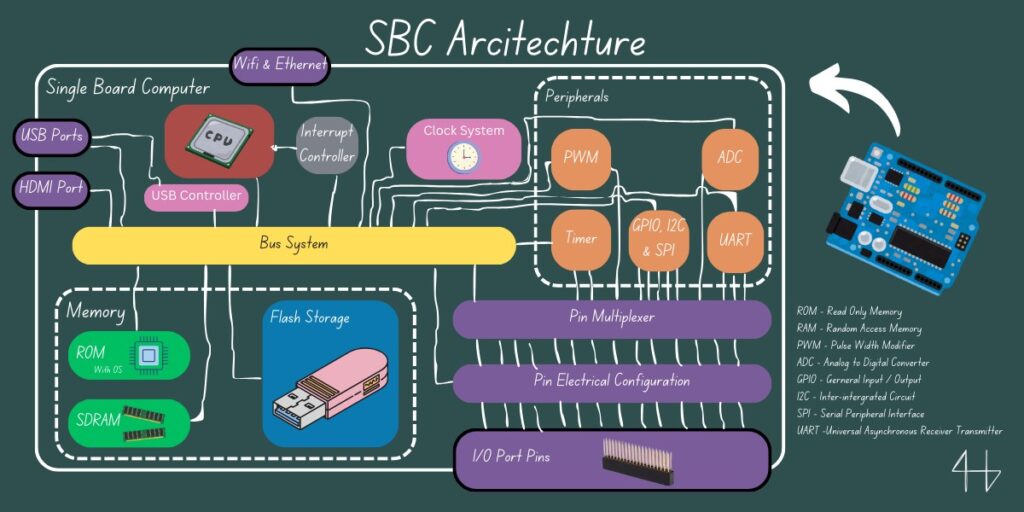
An SBC isn’t just a glorified circuit board—it’s a fully functional computer with:
- A CPU & GPU – The brain that processes data and handles graphics.
- RAM & Storage – Enough memory to run applications and store data.
- USB & HDMI Ports – Plug in peripherals or connect a display.
- GPIO Pins – Talk to IoT sensors and control hardware directly.
- Wi-Fi & Ethernet – Keep your IoT systems online and communicating.
SBCs vs. Microcontrollers: What’s the Difference?

| Feature | SBC | Microcontroller |
|---|---|---|
| Processing Power | High, can run Linux or Windows | Low, runs simple firmware |
| Connectivity | Wi-Fi, Ethernet, USB, HDMI | Limited, often just serial ports |
| Use Case | Data processing, automation, AI | Basic control, simple tasks |
| IoT Role | Can collect data, analyze, and send it to the cloud | Reads sensors, sends data elsewhere |
SBCs are for heavy lifting—think industrial automation, smart security systems, or even AI-powered cameras. Microcontrollers? They’re best for basic jobs like switching a light on and off.
If your IoT project needs real-time control with minimal power, a microcontroller is fine. But if you want to process IoT data, run multiple applications, and connect to the cloud, an SBC is the way to go.
Why Use SBCs in IoT?
Because your IoT technologies deserve more than a glorified calculator.
Single Board Computers bring serious computing power to the IoT world. They’re not just small—they’re smart, capable of running full operating systems and handling complex tasks. Need to control smart devices, process video feeds, or run AI models? An SBC has you covered.
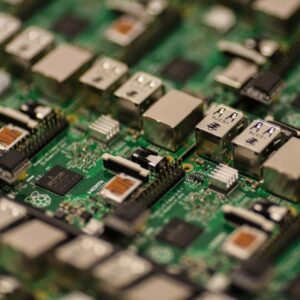
Here’s Why SBCs Rule the IoT Game:
- Brains Over Brawn – Unlike microcontrollers, single board computers can run AI inference, manage multiple devices, and even process video. That’s next-level IoT device management.
- OS for the Win – With support for Linux-based systems like Raspberry Pi OS and Ubuntu, single board computers offer flexibility, software compatibility, and tons of pre-built tools.
- Always Connected – Wi-Fi, Ethernet, Bluetooth, USB—single board computers come loaded with options to keep your devices talking to each other and the cloud.
- Jack of All Trades – From smart home hubs to industrial automation, single board computers can act as edge devices, controllers, or even full-fledged IoT gateways.
- Easy to Work With – Tons of pre-built libraries, tutorials, and community support make development a breeze—even if you’re just getting started.
Want a powerful, flexible, and scalable IoT brain? Skip the microcontroller and grab an SBC.
Popular SBCs for IoT Projects
Not all single board computers are created equal. Some are tiny powerhouses, some are AI wizards, and others are built to handle efficient data transfer in industrial settings. Whether you’re a hobbyist tinkering with smart gadgets or one of the many electrical and electronics engineers designing large-scale devices connected to the cloud, there’s an SBC for you.

The Heavy Hitters of IoT SBCs
- Raspberry Pi – The MVP of IoT. Whether it’s the compact Pi Zero W, the powerful Pi 4, or the keyboard-in-a-PC Pi 400, Raspberry Pi boards are versatile, affordable, and perfect for most projects.
- BeagleBone Black – Built for industrial IoT, this SBC has robust I/O support and real-time processing for demanding automation tasks.
- NVIDIA Jetson Nano – Need AI at the edge? This SBC is designed for machine learning, making it perfect for smart cameras, robotics, and AI-driven automation.
- Odroid Series – These high-performance single board computers pack serious computing power, ideal for computationally intensive applications that need more muscle than a Raspberry Pi.
- Arduino Portenta H7 – The best of both worlds. It merges microcontroller simplicity with SBC-level processing power for IoT projects that need flexibility.
- Espressif ESP32-S3 Box – Budget-friendly, efficient, and built for lightweight IoT applications with edge AI capabilities. A great pick for simple automation.
- ASUS Tinker Board – If your IoT project involves multimedia, this SBC delivers high-quality audio and video processing, perfect for smart displays and kiosks.
Each of these boards brings something unique to the table. Picking the right one depends on what your IoT project needs—power, connectivity, AI, or simplicity.
How to Choose the Right SBC for Your IoT Project
Picking the right SBC is like choosing the perfect tool for a job—you wouldn’t use a chainsaw to cut butter, right? Whether you’re building smart objects, designing a remote control system, or developing a sleek graphical user interface, the right SBC makes all the difference.
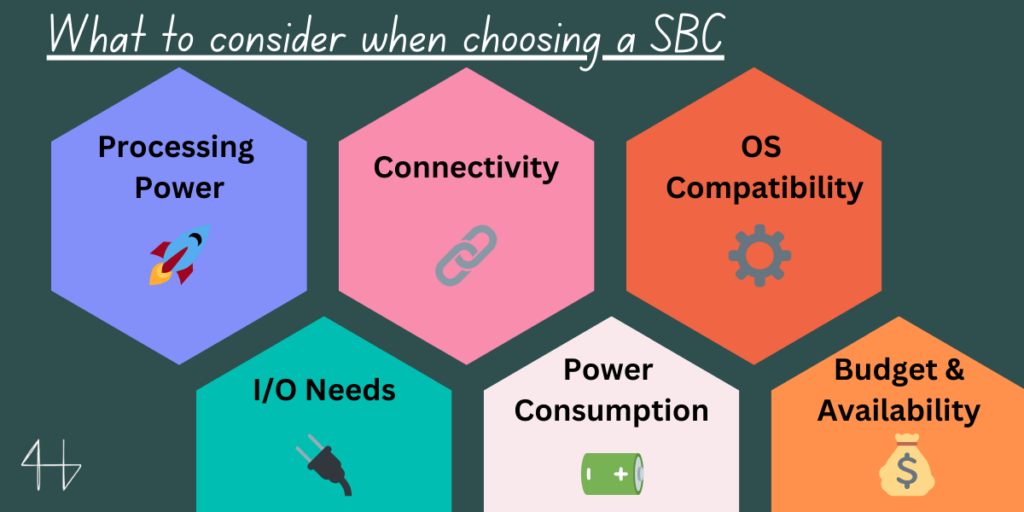
Here’s what to consider:
- Processing Power – Need AI or video processing? Go for an SBC with a solid CPU and GPU. Just controlling a few sensors? A simpler board will do.
- Connectivity – Wi-Fi, Bluetooth, or Ethernet? Make sure your SBC can talk to the rest of your IoT network.
- OS Compatibility – If your project needs Linux, Windows, or Android, pick an SBC that supports it. Some boards only run lightweight firmware.
- I/O Needs – Want to plug in sensors, screens, or external devices? Check for GPIO pins, USB ports, HDMI output, and other expansion options.
- Power Consumption – Building a battery-powered project? Some single board computers sip power, while others drain it like a high-performance sports car.
- Budget & Availability – The best SBC is the one you can actually get your hands on—without breaking the bank.
Think about what your IoT project actually needs. Overkill can waste money and power, while an underpowered SBC can leave your project struggling to keep up. Balance is key!
Use Cases of SBCs in IoT Development
Single board computers are the Swiss Army knives of IoT. Whether it’s managing smart buildings, optimizing energy management systems, or powering connected cars, these tiny computers handle big tasks.
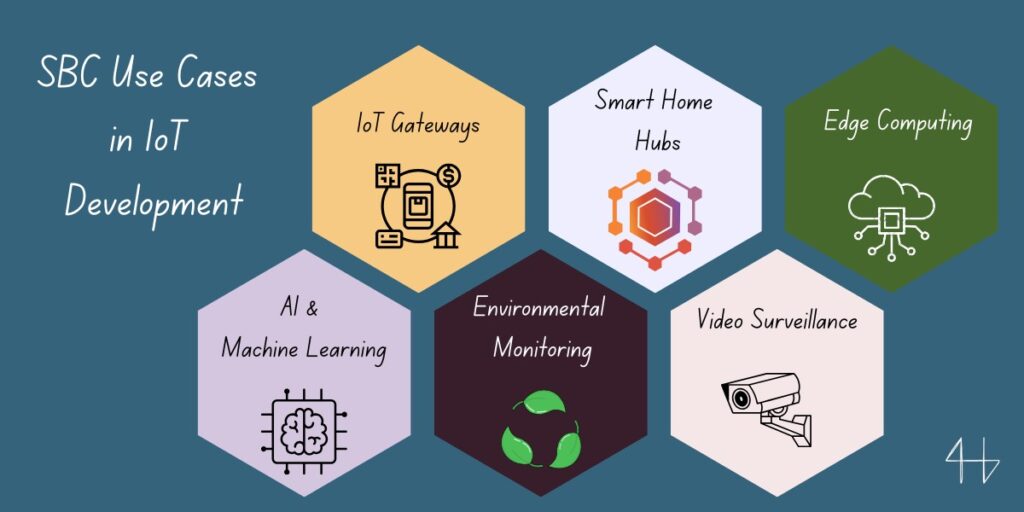
Where SBCs Shine in IoT
- IoT Gateways – single board computers act as middlemen, collecting and processing data from multiple sensors before sending it to the cloud. They help reduce latency and bandwidth use.
- Smart Home Hubs – A Raspberry Pi can be the brain of a smart home, controlling everything from lights to security cameras—all in one place.
- Edge Computing – Instead of sending everything to the cloud, SBCs process real-time data at the edge, making AI and analytics faster and more efficient.
- AI & Machine Learning – Need an SBC that thinks? Boards like the Jetson Nano can run AI models locally for smart automation and decision-making.
- Environmental Monitoring – Want to track air quality or temperature? Single board computers paired with sensors can collect and analyze data before pushing it to the cloud.
- Video Surveillance – Single board computers with GPUs handle live video streaming and analysis, perfect for smart security systems and automated monitoring.
From tiny DIY projects to large-scale automation, single board computers are the go-to choice for handling IoT tasks with flexibility and power.
The Pros, Cons, and Challenges of Using SBCs in IoT
Single board computers are like the multi-tool of IoT—versatile, powerful, and ready to handle everything from internet-connected devices to data encryption. But like any tool, they have their strengths and weaknesses.
Pros
Cons
Overcoming SBC Challenges
- Heat Management – If you’re pushing your SBC to its limits, heatsinks or fans can prevent overheating.
- Storage Space – Most single board computers have limited onboard storage—expand it with microSD cards or external SSDs.
- Reliability Matters – Keep your SBC running smoothly by protecting it from power surges and unstable power supplies.
- Connectivity Fixes – Wi-Fi and Bluetooth issues? Optimize placement, update drivers, or switch to wired Ethernet for seamless connections with other IoT devices.
Single board computers are powerful but not perfect. Choosing the right one—and managing its quirks—can make or break your IoT project!
Beginner-Friendly IoT Projects & Resources to Get You Started
Diving into SBC-powered IoT? Start small but think big! Whether you’re automating smart home devices, experimenting with IoT protocols, or connecting connected devices, there’s no shortage of fun beginner projects.
Easy IoT Projects to Try
<Image of IoT Projcets>
- Smart Mirror – A Raspberry Pi-powered mirror that shows weather, time, and news. A sleek way to start your day!
- IoT Weather Station – Collect environmental data, display it on a web dashboard, and pretend you’re a meteorologist.
- AI-Based Object Detection – Use a Jetson Nano to recognize objects in real-time—because your SBC deserves to feel smart.
- Home Automation Controller – Manage lights, temperature, and security using an SBC. Who needs a fancy home automation system when you can DIY?
- DIY NAS (Network Attached Storage) – Turn your Raspberry Pi into a personal cloud server. No subscription fees, just pure data freedom.
Resources to Learn More
- Online Courses – Platforms like Udemy, Coursera, and YouTube have step-by-step guides on SBCs and IoT.
- Official Docs – Need the nitty-gritty details? Check out documentation for Raspberry Pi, BeagleBone, and Jetson Nano.
- Community Support – Stuck? Ask the pros on Raspberry Pi Stack Exchange, Hackster.io, or Reddit.
- Tutorials & Projects – Websites like Instructables, Hackaday, and GitHub are goldmines for inspiration.
The best way to learn? Pick a project, start tinkering, and get your hands dirty. Your future self—running a home full of automated gadgets—will thank you!
Conclusion
Single Board Computers (SBCs) are the brains behind the brawn of modern IoT. From powering smart home devices to running AI on the edge, these tiny computers make connected devices smarter, faster, and more versatile. Whether you’re managing IoT protocols in an industrial setup or just automating your living room lights, SBCs give you the power to build, experiment, and innovate.
If you’re new to IoT, start small. A Raspberry Pi and a simple project—like a smart mirror or weather station—can teach you everything you need to know before tackling advanced AI or automation tasks.
FAQs

What is a signle board computer?
A single-board computer (SBC) is a complete computer built on a single circuit board, integrating a microprocessor, memory, I/O interfaces, and power management. It operates independently without needing additional peripherals
Are single board computers worth it?
Yes, they are worth it for applications requiring compactness, low power consumption, and cost-effectiveness, such as embedded systems, robotics, and automation
Is Arduino a single board computer?
Arduino is not typically considered a single-board computer because it lacks the ability to run multiple applications and a full-fledged operating system like Linux or Windows. It is more accurately described as a microcontroller board
What is the future of single board computers?
The future of SBCs involves improved performance, enhanced graphics capabilities, better connectivity options (e.g., Wi-Fi, Bluetooth), and increased security features. They will be more specialized for applications like AI, IoT, and industrial automation

